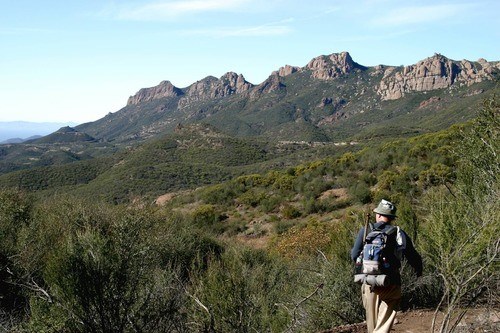Learn about NRCAs
The Natural Resource Condition Assessment (NRCA) Program provides framework, funding, and publishing support to parks to aid in the synthesis and documentation of natural resource conditions. Condition assessment reports are a tool to describe selected park resources, and record a snapshot of their current condition, identify trends, and identify potential or current threats and stressors. Understanding the condition and trend of natural resources is key for parks and NPS planners to appropriately prioritize and allocate stewardship resources.

NPS Photo
There is tremendous ecological diversity within the Santa Monica Mountains. The mountains are home to over 1,000 plant species making up 26 distinct natural communities, from freshwater aquatic habitats and two of the last salt marshes on the Pacific Coast, to oak woodlands, valley oak savannas, coastal sage, and chaparral. Numerous mammals are found in the Santa Monica Mountains, including bobcats, coyotes, and mountain lions. Nearly 400 species of birds have been observed and another 35 species of reptiles and amphibians can also be found in the mountains. The Santa Monica Mountains are home to more than 50 threatened or endangered plants and animals - among the highest concentrations of such rare species in the United States.
Traditional NRCA Report: 2013
In an effort to better understand the natural resources and processes found within the park, a Natural Resource Condition Assessment was conducted and published in 2013. The assessment was a collaborative effort between the National Park Service and the Donald Bren School of Environmental Science & Management. This team chose 13 natural resource topics and stressors to be evaluated:
- Housing development |
- Climate |
|||||
- Road distance and accessibility |
- Water quality |
|||||
- Pesticides impacting amphibians |
- Invasive plants |
|||||
- Rodenticides |
- Fire regime |
|||||
- Human foot print |
- Predicted future fire regime |
|||||
- Air quality |
- Habitat connectivity |
|||||
- Dark night sky |
Natural resource conditions at the park varied. The condition assessment identified a number of emerging issues that may become of greater management concern in the future. The most obvious of these is climate change from anthropogenic emissions of greenhouse gases. Increasing human occupancy and activity in the region will undoubtedly amplify other stressors to the area as well.
For other reports and natural resource datasets visit the NPS Data Store.
Source: NPS DataStore Collection 7765 (results presented are a subset). To search for additional information, visit the NPS DataStore.
Last updated: February 25, 2022
